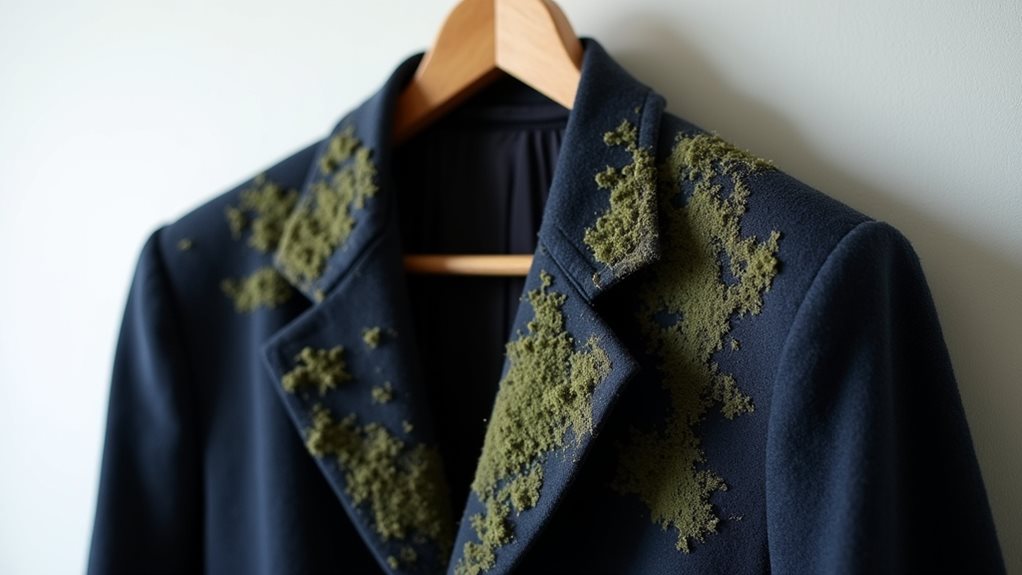Yes, dry cleaning can effectively remove most types of mold from your clothing, especially surface-level infestations on delicate fabrics. The chemical solvents like perchloroethylene, combined with high-temperature drying at 60-63°C, kill common household molds including Aspergillus and Cladosporium. However, stubborn black mold or deeply embedded spores in porous materials like cotton may require multiple treatments or specialized pre-treatment methods. Success depends on mold penetration depth, and you’ll want to explore prevention strategies to keep those pesky spores away.
Understanding How Mold Develops on Clothing and Fabrics
When I first discovered that fuzzy green patch on my favorite wool coat after pulling it from storage, I felt that sinking feeling you get when you realize you’ve been storing your clothes all wrong.
Mold thrives in warm, moist environments where poor ventilation creates the perfect storm for spore development, and fabrics like cotton absorb moisture like tiny sponges, providing nutrients that feed these unwelcome guests.
Cotton fabrics become moisture magnets in poorly ventilated spaces, creating the ideal feast for hungry mold spores.
Those protective bags we think are helping? They’re actually trapping moisture, creating cozy breeding grounds.
Residual dirt and body oils become mold’s favorite snacks, making removal even trickier.
When you spot that telltale musty smell or colorful growths ranging from white to black, it’s time to reflect on whether dry cleaning can save your treasured garments.
While dry cleaning uses chemical solvents like perchloroethylene that can kill some mold spores, it’s not always a complete solution for mold remediation.
The Science Behind Dry Cleaning and Solvent-Based Cleaning
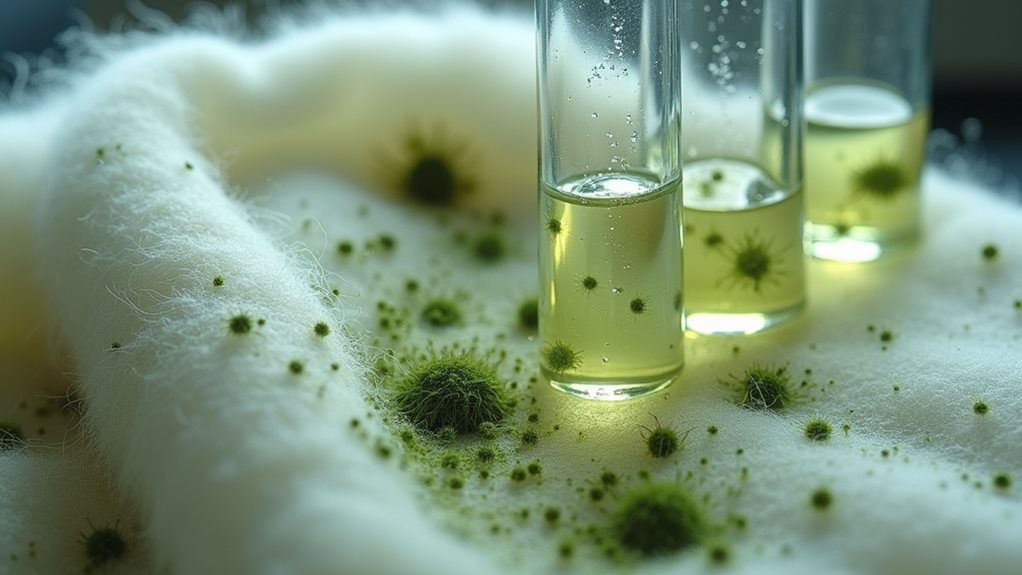
Now that we’ve identified the enemy lurking in our closets, let’s explore how dry cleaning wages war against mold using chemistry rather than water.
When you take your precious garments to a professional dry cleaner, they’re fundamentally giving them a sophisticated chemical bath that your washing machine simply can’t replicate.
The solvents used in dry cleaning, particularly perchloroethylene, work like molecular warriors, dissolving oils and greases that harbor stubborn mold spores.
Here’s what makes this cleaning process so effective:
- Gentle agitation minimizes fabric damage while maximizing mold removal
- High-temperature drying (60-63°C) kills resilient mold variants
- Pre-treatment solutions target specific mold stains before the main wash
This scientific approach can remove mould more thoroughly than traditional water-based methods! 🧪
However, dry cleaning may struggle with deeply embedded spores on porous materials like wool or cotton, where mold has had time to penetrate the fabric fibers extensively.
Effectiveness of Dry Cleaning Against Different Types of Mold
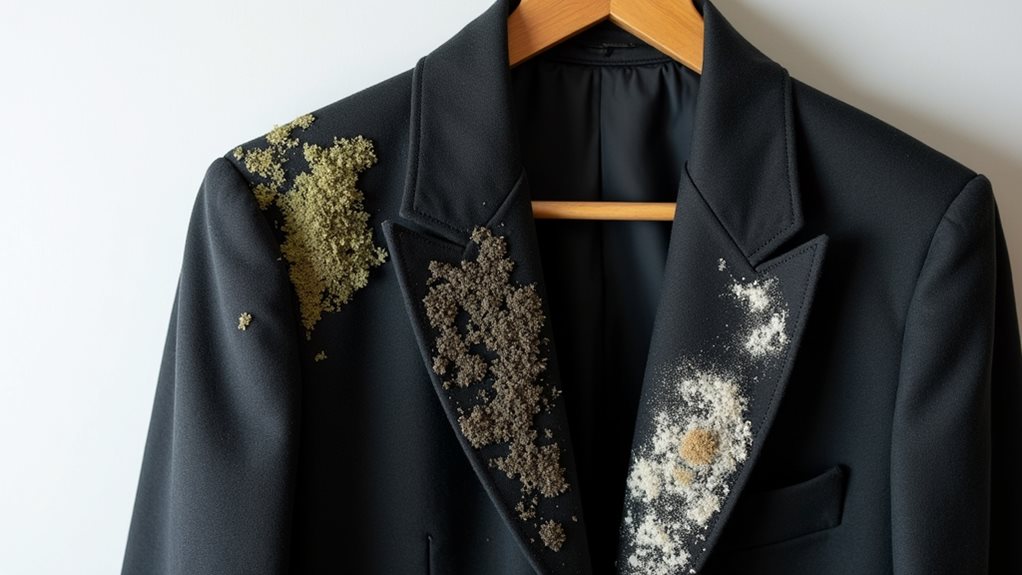
Although dry cleaning’s chemical arsenal packs a serious punch against mold, the battlefield isn’t always level—some mold species practically surrender on contact, while others dig in like stubborn teenagers refusing to clean their rooms.
You’ll find that common household molds like Aspergillus and Cladosporium typically can’t withstand the heat and solvents used in professional dry cleaning, making it relatively straightforward to remove these pesky invaders from your favorite blazer.
However, black mold (Stachybotrys) proves more resilient, often requiring multiple treatments or specialized pre-cleaning protocols. The effectiveness really depends on how deeply those mold spores have penetrated your fabric’s fibers—surface-level infestations respond beautifully, while deeply embedded colonies might need extra attention from your dry cleaner’s expertise.
Be sure to inform your cleaner about potential mold issues beforehand, as some facilities may refuse to process heavily contaminated items to prevent cross-contamination throughout their facility.
Pre-Treatment Methods for Heavily Contaminated Garments
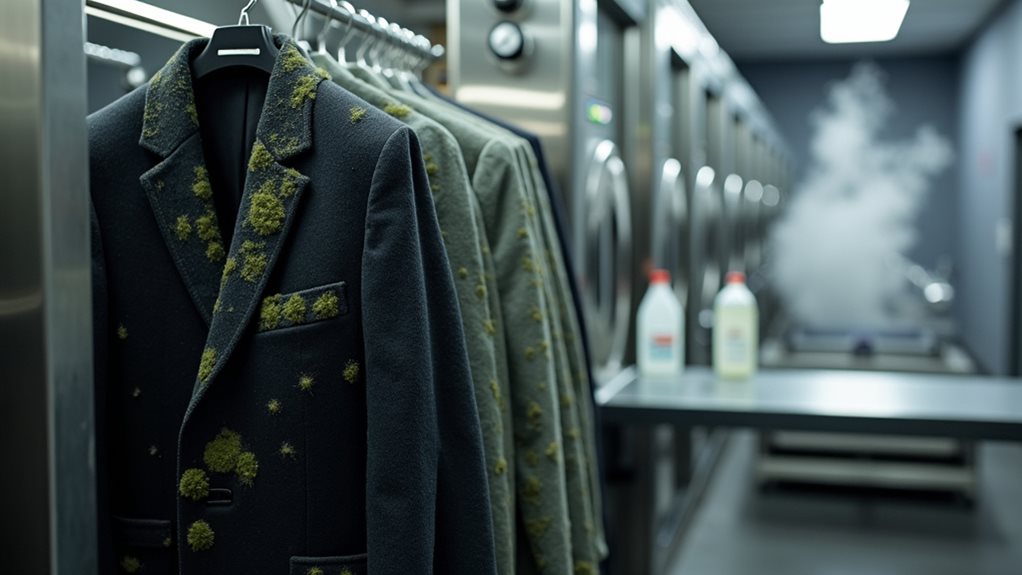
When you’re facing heavily contaminated garments that look like they’ve survived a science experiment gone wrong, you’ll need to tackle three vital pre-treatment steps that can make or break your mold removal success.
First, you’ll want a professional assessment and thorough inspection to determine whether your favorite blazer is salvageable or destined for the trash bin, because trust me, I’ve learned the hard way that wishful thinking doesn’t eliminate stubborn spores.
Next, you’ll implement specialized stain removal techniques and heat treatment applications that work together like a well-choreographed dance, breaking down those protein-based mold compounds while your dry cleaner applies the precise temperature and chemical combinations needed to restore your garments to their former glory.
For severely contaminated items, professional mold remediation services may be required before any dry cleaning attempts, as standard cleaning processes alone might not penetrate deeply embedded spores that have established themselves in fabric fibers.
Professional Assessment and Inspection
Before you hand over that moldy blazer to your dry cleaner, understanding what happens during professional assessment can save you both disappointment and money 💸.
Your cleaner isn’t just eyeballing the damage—they’re conducting a thorough investigation that determines whether your garment can be salvaged or needs to find a new home in the trash bin.
Here’s what happens during professional assessment:
- Visual inspection to identify mold extent and contamination severity
- Fabric type evaluation to determine appropriate cleaning techniques
- Treatment recommendation based on whether pre-treatment methods will be effective
I’ve learned the hard way that some items are beyond saving, and experienced cleaners can spot these immediately.
Their expertise in mold removal helps them match the right approach to your specific situation, potentially saving you from costly disappointment.
Similar to how dry cleaning effectively eliminates bed bugs through high heat temperatures of 140°F or higher, the thermal processes used in professional dry cleaning can also help address certain types of contamination in fabrics.
Specialized Stain Removal Techniques
Once your cleaner identifies a garment that’s salvageable, they’ll roll up their sleeves and get to work with specialized pre-treatment techniques that can make the difference between rescue and ruin.
Think of specialized stain removers as tiny warriors targeting the organic buffet that mold loves to feast on – proteins, oils, and other microscopic goodies that keep these unwanted guests thriving.
Professional mould removal services often reach for oxygen bleach when dealing with stubborn cases, boosting their effective cleaning power while tackling those musty odors that seem to cling like unwelcome memories.
Sometimes heavily contaminated pieces need multiple rounds of treatment, and honestly, proper drying afterward becomes just as essential as the initial attack plan.
However, traditional dry cleaning processes may use perchloroethylene, a chemical solvent that requires proper ventilation and handling during the mold removal treatment.
Heat Treatment Applications
While specialized stain removers work their magic on the surface, the real heavy-lifting begins when your dry cleaner cranks up the heat to tackle those deeply embedded mold colonies that have made themselves completely at home in your favorite fabrics.
Here’s what happens during heat treatment applications:
- Temperature targeting – Your dry cleaning process reaches 60-63°C, creating an inhospitable environment that kills most mold variants lurking in fabric fibers.
- Deep penetration – Heat works alongside pre-treatment chemicals to reach areas where surface treatments can’t touch.
- Professional assessment – Experienced cleaners evaluate contamination levels to determine if multiple heat cycles are necessary.
Many facilities are moving away from traditional perchloroethylene toward safer alternatives like wet cleaning and liquid CO2 systems that reduce both environmental impact and health risks for workers handling contaminated garments.
Prevention Strategies to Stop Mold Growth After Cleaning
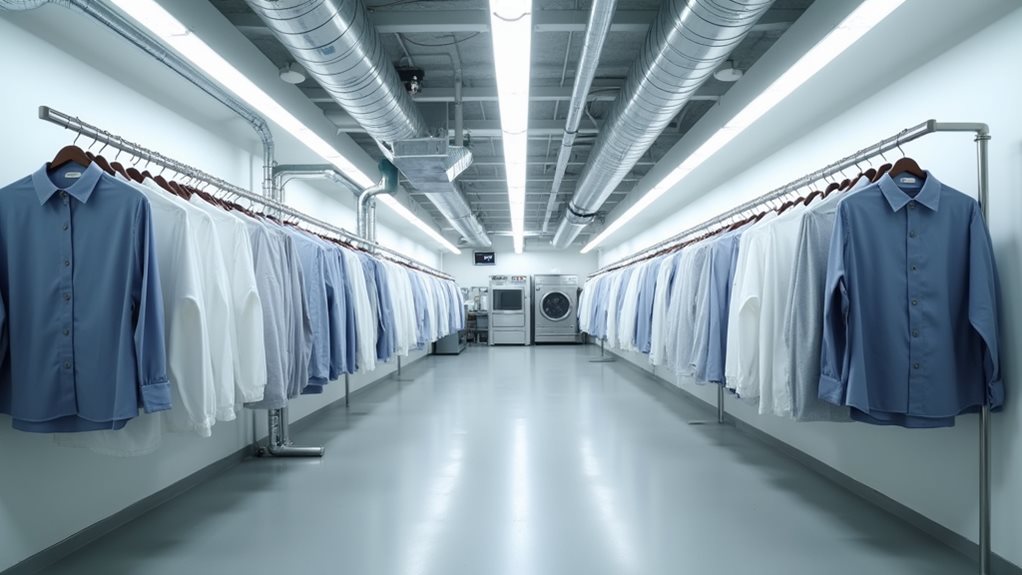
After successfully removing mold from your clothes through dry cleaning, you’ll want to focus on proper storage techniques and environmental moisture control to prevent that stubborn fungus from making an unwelcome comeback in your wardrobe.
I learned this lesson the hard way when my freshly cleaned winter coats developed new mold spots within weeks because I stored them in my damp basement without thinking twice about humidity levels 🤦♀️.
The key lies in creating an environment where mold simply can’t thrive, which means controlling moisture through strategic storage choices and maintaining ideal humidity levels in your closets and storage areas.
Remember that proper ventilation and humidity control are essential prevention strategies, as even professional cleaning can’t protect your garments if they’re returned to the same moisture-rich conditions that allowed mold to develop initially.
Proper Storage Techniques
Since dry cleaning successfully removes existing mold from your garments, you’ll want to protect that investment by storing your freshly cleaned clothes properly—because honestly, there’s nothing more frustrating than spending money on professional cleaning only to find those pesky spores creeping back within weeks.
Here’s how to keep your garments mold-free after dry cleaning remove mold treatment:
- Choose breathable storage options like cotton garment bags instead of plastic containers that trap humidity.
- Ensure clothes are properly dry before storing, allowing air to circulate freely around each piece.
- Add moisture absorbers such as silica gel packets to prevent moisture buildup in closets.
If your dry cleaner fails to properly remove mold or damages your garments during the cleaning process, know that you have consumer rights to seek compensation or remedial action.
Environmental Moisture Control
Beyond storage considerations, you’ll need to tackle the bigger picture of environmental moisture control throughout your living space, because even the most breathable garment bags won’t save your clothes if your entire home feels like a tropical rainforest.
Trust me, I learned this the hard way when my basement became a mould paradise after a particularly humid summer 😅.
To prevent this nightmare scenario, invest in a quality dehumidifier for problem areas, guarantee your HVAC system circulates air properly, and don’t underestimate the power of simple exhaust fans in bathrooms and laundry rooms.
Regular moisture monitoring with inexpensive hygrometers helps you catch issues before they become expensive cleaning disasters, protecting both your storage investments and your peace of mind.
When Professional Mold Remediation Services Are Necessary
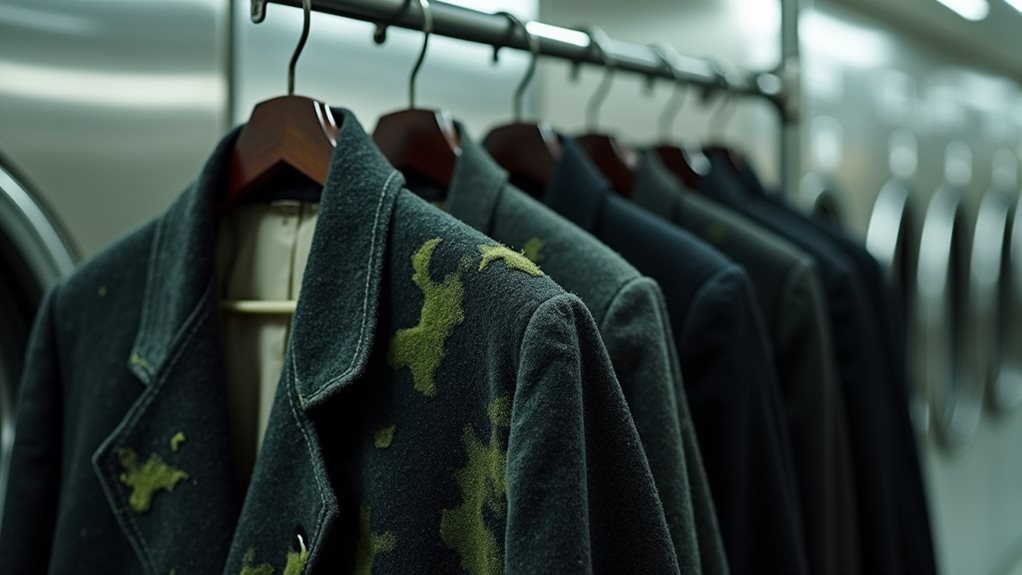
While I’d love to tell you that every moldy garment can be saved with a simple trip to the dry cleaner, the truth is that sometimes you need to bring in the heavy hitters – professional mold remediation services.
When mold infestations have penetrated deeply into fabric fibers, or when you’re experiencing health symptoms like persistent coughing or sneezing, it’s time to call the experts.
Here’s when you absolutely need professional help:
- Extensive mold coverage that’s spread beyond surface areas
- Vintage garments or designer pieces worth considerable money
- Health risks are present, especially for family members with allergies
Professional services create customized treatment plans using specialized equipment and controlled environments, guaranteeing thorough removal while protecting your investment and well-being.

